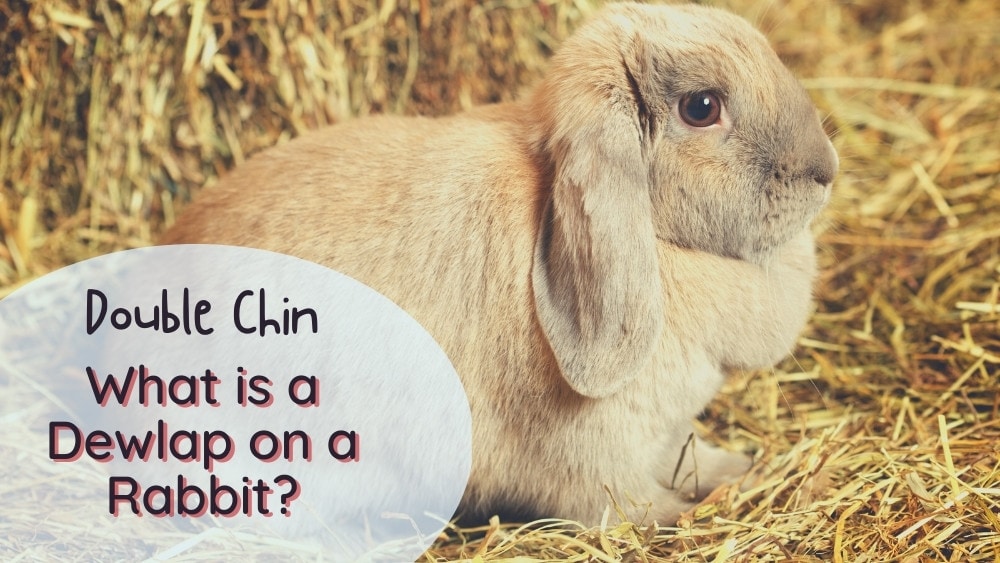If you’ve noticed what appears to be a double chin on your rabbit or on bunnies in pictures, don’t worry! It’s completely normal. Unlike me, rabbits don’t actually have double chins – what you’re seeing is called a dewlap!
So, what is a rabbit dewlap? This article will answer this question and tell you all about dewlaps. We’ll also cover potential health issues to keep an eye out for.
What is a Dewlap on a Rabbit?
A dewlap is a fold of skin containing fatty tissue found underneath a rabbit’s jaw. Dewlaps are primarily seen in sexually mature female rabbits, although some male rabbits have them. Dewlaps can be a small ‘bump’ or a large layer of fatty tissue around the neck.
Rabbit Dewlap Basics
Why Do Rabbits Have Dewlaps?
Female rabbits have dewlaps to pull fur from when they’re pregnant! Yes, you read that right – does (female rabbits) pluck their fur from their dewlaps. A female bunny does this to line her nest to make it comfy and warm ready for her babies’ arrival.
A rabbit plucking at its fur can look strange if you’ve never seen it before! But as long as there are no bald patches, there’s nothing to worry about.
If your doe hasn’t been around male rabbits and you see her plucking hair from her dewlap, it might be a sign of false pregnancy.
If your doe is spayed, she might still have a dewlap, but she shouldn’t be plucking fur from it. Spayed does sometimes have false pregnancies, but this is rare. If your doe isn’t pregnant and you see her pulling out her fur, it’s best to get her checked by a vet.
Dewlap Development
Female rabbits aren’t born with dewlaps – they develop as a doe reaches sexual maturity. Does typically reach sexual maturity between three and six months old, depending on their size and breed.
At this point, the dewlap will start to grow and continue to develop over the next couple of years. If you have your female bunny spayed, the dewlap will stop growing gradually, but it won’t disappear.
Dewlap Size
The size of a rabbit’s dewlap depends on many factors, including its breed, size, genetics, weight, and sexual maturity. Small dewlaps look like little bumps, while big dewlaps look sort of like a pillow that your rabbit rests its chin on. They can look quite funny at times!
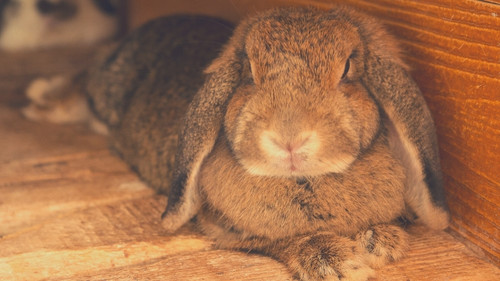
Large breed rabbits and lop breeds tend to have bigger dewlaps. When I was at animal care college, we had some Continental Giant Rabbits, and they had huge dewlaps! I remember thinking it made them look extra cuddly and cute.
Do Male Rabbits Have Dewlaps?
Male rabbits are known as bucks. Some bucks can have dewlaps, but they’re not as large or noticeable as does’ dewlaps. Male rabbits of certain breeds, particularly large or lop breeds, are more likely to have a dewlap.
In some cases, a buck having a dewlap means he is overweight. As a buck gains weight, the fatty tissue inside his dewlap increases, making it bigger. Rabbits need an appropriate diet to maintain a healthy weight.
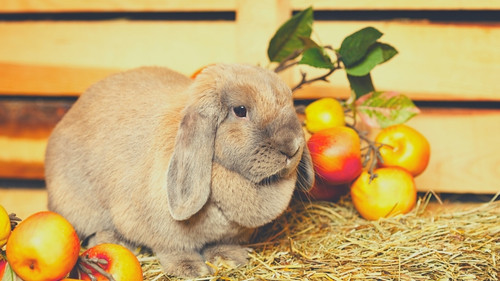
My lovely male rabbit Hopkins had a small dewlap. He was a lop-eared breed, so the dewlap itself wasn’t unusual. When we rescued him, he had been badly treated and didn’t have a good diet, so he was overweight. Over time as we got him on a good diet and gave him plenty of exercise, his dewlap reduced in size and was more comfortable for him to live with.
It’s thought that male rabbits with dewlaps may have higher estrogen levels than other bucks, although evidence is lacking around this theory. Estrogen is a sex hormone that controls female sexual development and reproduction. Therefore bucks with noticeable dewlaps are typically not used by breeders.
If your male rabbit has a dewlap and you’re unsure if it’s because of his breed, it’s best to get him checked by a vet. They can rule out any other causes and help ensure your rabbit is at the right weight.
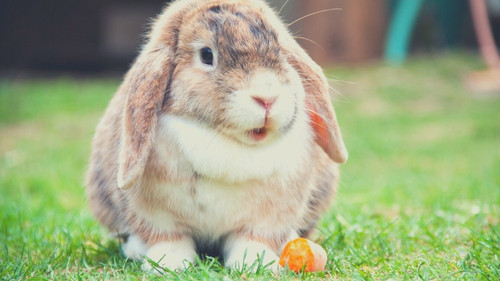
Rabbit Breeds With Dewlaps
In theory, any rabbit breed can have a dewlap. Dewlaps are most commonly seen in the following breeds:
- Flemish Giant
- Lop breeds
- Californian
- American Chinchilla
- Giant Chinchilla
- New Zealand
- Havana
- Rex breeds
- Satin
Rabbit breeds that are least likely to have a dewlap include the following:
- Britannia Petite
- Himalayan
- Dwarf Hotot
- Netherland Dwarf
- Polish
If these breeds do have dewlaps, they tend to be very small. In the rabbit show world, some of these breeds would be disqualified for having dewlaps as they’re not part of the breed standard.
Why Doesn’t My Female Rabbit Have a Dewlap?
If your female rabbit doesn’t have a dewlap, it’s probably nothing to worry about. Some bunny breeds don’t develop noticeable dewlaps. It might be that your bunny does have a dewlap, but it’s so small that you can’t see it!
If your doe is under a year old, her dewlap won’t have developed yet. It will likely develop over the coming months as she reaches sexual maturity.
Female rabbits that are spayed before sexual maturity either won’t develop dewlaps, or the dewlap will stay very small and underdeveloped.
Unless you plan to breed from your doe or show them, a lack of dewlap won’t be a problem. Your bunny won’t miss her ‘double chin’!
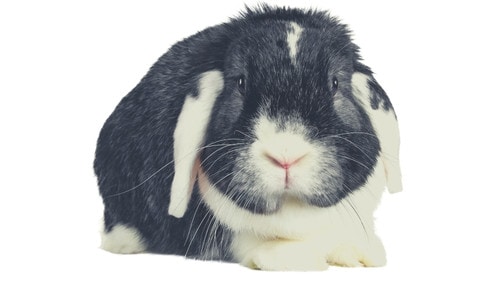
Dewlap Health Issues
Despite dewlaps being a natural part of a rabbit’s body, they can come with potential health issues.
Oversized Dewlaps
If your bunny has a very large dewlap, it can make your rabbit uncomfortable. Oversized dewlaps can even cause problems with your bunny’s range of motion!
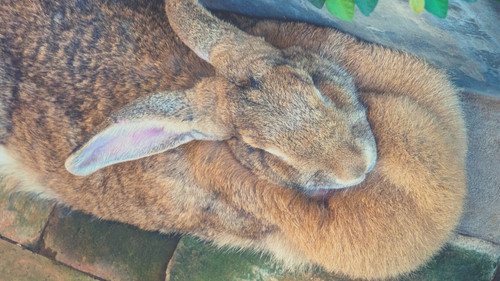
Grooming
With a large dewlap, your rabbit might not be able to reach its body to groom itself properly.
Lack of proper grooming can lead to mats in your rabbit’s fur and a build-up of dirt. This can lead to health issues such as infections because your bunny can’t keep itself clean. Very dirty fur can even attract flies which can result in flystrike.
Imagine not being able to have a shower for a long time! It would be distressing, to say the least.
Eating and Drinking
Some rabbits with big dewlaps struggle to eat or drink. When they do eat or drink, food debris and water can get all over their dewlaps. The debris can get stuck in the folds of the rabbit’s skin. It’s not very nice to think about and is even worse for your bunny. It’s not only uncomfortable but can also cause skin irritations and infections.
In severe cases, your bunny may not feel like eating or drinking because it’s uncomfortable for them.
Dehydration and hunger can lead to dangerous health issues in rabbits.
What Can You Do About An Oversized Dewlap?
You can talk to your vet if your rabbit has a large dewlap because it’s overweight. Your vet can help you adjust your bunny’s diet and exercise so it can lose weight.
If your rabbit struggles with grooming, you will need to do the work for it with regular cleaning and brushing.
Water bottles can help bunnies with large dewlaps to drink.

It’s often easier for them to access water from a bottle than from a bowl, and bottles prevent water from spilling down their chin. If your bunny gets food on its dewlap, make sure to clean it up to avoid skin irritation.
In severe cases, your vet may recommend a dewlap reduction surgery. Making your rabbit’s dewlap smaller may improve its quality of life.
Wet Dewlaps
When a rabbit’s dewlap is constantly wet, it can cause skin irritation, inflammation, and infection. The condition is known as moist dermatitis or simply ‘wet dewlap.’
Causes of Wet Dewlap
Wet dewlaps in rabbits can be caused by:
- A large dewlap that gets in the way of drinking
- A rabbit drinking from a bowl rather than a bottle and getting water down its chin
- Dental conditions that cause drooling
- Damp bedding
- A rabbit drinking from a bowl without tilting its head so its chin gets in the water
- A leaking water bottle
- Syringe feeding when a rabbit is sick (the wet food solution often spills onto the chin and dewlap)
- Living in an unhygienic environment
Symptoms of Moist Dermatitis
If your rabbit has moist dermatitis, you might notice the following symptoms:
- A wet chin and dewlap area anytime you play with them or pet them
- Hair loss around the dewlap
- Red, inflamed, and sore-looking skin on the dewlap and chin
- The area may turn green if it becomes infected
- A rotten smell from the dewlap
- In severe cases, the sores may attract flies and you may see maggots crawling on the dewlap (a horrible thought I know)
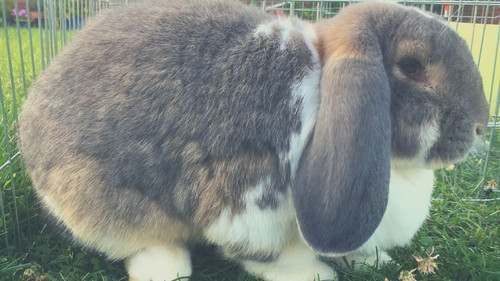
Treatment and Prevention
Take your bunny to the vet if you notice any signs of moist dermatitis. The vet will likely trim or shave the hair in the affected area and apply an antiseptic powder. If the infection is severe, they may prescribe antibiotics for your bunny.
You can prevent moist dermatitis by:
- Regularly grooming and health checking your bunny so you can notice signs of a wet dewlap early on
- Keeping your rabbit’s enclosure clean
- Providing a water bottle if your rabbit has a large dewlap
- Regularly checking that your rabbit’s water bottle is leak-free
- Providing lots of hay and chew toys to prevent dental issues
- Checking your bunny’s teeth regularly
Conclusion
Dewlaps are a natural occurrence for sexually mature female rabbits and some male bunnies. Dewlaps vary in size, but unless they’re very large, they shouldn’t cause any health issues. Keeping an eye on your bunny’s dewlap helps to keep your rabbit healthy.
Did you find this article helpful? If you have any questions about dewlaps feel free to leave them in the comments below.


